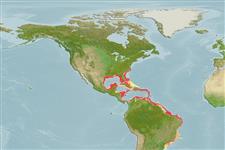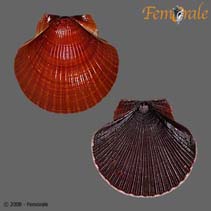Euvola ziczac (Linnaeus, 1758)
Zigzag scallop| Native range | All suitable habitat | Point map | Year 2050 |

|
| This map was computer-generated and has not yet been reviewed. |
| Euvola ziczac AquaMaps Data sources: GBIF OBIS |
Classification / Names Common names | Synonyms | CoL | ITIS | WoRMS
Bivalvia | Pectinida | Pectinidae
Environment: milieu / climate zone / depth range / distribution range Ecology
Benthic; depth range 1 - 151 m (Ref. 101602). Tropical; 35°N - 29°S, 98°W - 34°W
Distribution Countries | FAO areas | Ecosystems | Occurrences | Introductions
Western Atlantic and Western Central Pacific: From North Carolina and Bermuda, to Santa Catarina State, Brazil; Philippines.
Length at first maturity / Size / Weight / Age
Maturity: Lm ? range ? - ? cm Max length : 9.0 cm SHL male/unsexed; (Ref. 83435); common length : 11.0 cm SHL male/unsexed; (Ref. 344)
Short description Morphology
Shell circular, inequivalve, lower valve strongly concave, upper valve flatter, slightly convex. Hinge with wing-like projections of equal size. Sculpture on upper (flat) valve of about 35 ribs and interspaces of about same width. Lower (deep) valve with about 20 less prominent ribs. Colour: tan to light brown. Inner surface of lower valve white. Upper valve mottled with reddish brown and dark brown markings.
Life cycle and mating behavior Maturity | Reproduction | Spawning | Eggs | Fecundity | Larvae
Members of the class Bivalvia are mostly gonochoric, some are protandric hermaphrodites (Ref. 833). Species is a hermaphrodite exhibiting asynchronous reproduction. Spawning occurs during summer, autumn and spring. Protandric individuals dominate during spring time while proterogynous individuals dominate in summer and autumn (Ref. 93548). Life cycle: Embryos develop into free-swimming trocophore larvae, succeeded by the bivalve veliger, resembling a miniature clam (Ref. 833).
Main reference
References | Coordinator | Collaborators
Leal, J.H. 2003. (Ref. 344)
IUCN Red List Status (Ref. 130435: Version 2024-1)
CITES status (Ref. 108899)
Not Evaluated
CMS (Ref. 116361)
Not Evaluated
Threat to humans
Human uses
Fisheries: commercial
| FishSource |
Tools
More information
Trophic Ecology
Ecology
Population dynamics
Life cycle
Distribution
Human Related
Aquaculture profile
Stamps, Coins Misc.
Stamps, Coins Misc.
Outreach
References
Internet sources
BHL | BOLD Systems | CISTI | DiscoverLife | FAO(Publication : search) | Fishipedia | GenBank (genome, nucleotide) | GloBI | Gomexsi | Google Books | Google Scholar | Google | PubMed | Tree of Life | Wikipedia (Go, Search) | Zoological Record
Estimates based on models
Preferred temperature
(Ref. 115969): 22.9 - 28, mean 26.5 (based on 370 cells).



